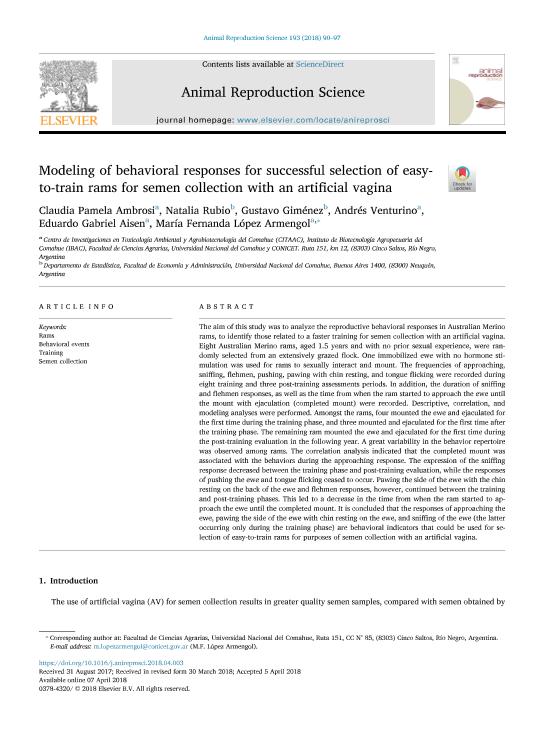Mostrar el registro sencillo del ítem
dc.contributor.author
Ambrosi, Claudia Pamela

dc.contributor.author
Rubio, Brenda Natalia

dc.contributor.author
Giménez, Gustavo
dc.contributor.author
Venturino, Andrés
dc.contributor.author
Aisen, Eduardo Gabriel

dc.contributor.author
Lopez Armengol, Maria Fernanda

dc.date.available
2020-08-07T16:19:44Z
dc.date.issued
2018-05
dc.identifier.citation
Ambrosi, Claudia Pamela; Rubio, Brenda Natalia; Giménez, Gustavo; Venturino, Andrés; Aisen, Eduardo Gabriel; et al.; Modeling of behavioral responses for successful selection of easy-to-train rams for semen collection with an artificial vagina; Elsevier Science; Animal Reproduction Science; 193; 5-2018; 90-97
dc.identifier.issn
0378-4320
dc.identifier.uri
http://hdl.handle.net/11336/111176
dc.description.abstract
The aim of this study was to analyze the reproductive behavioral responses in Australian Merino rams, to identify those related to a faster training for semen collection with an artificial vagina. Eight Australian Merino rams, aged 1.5 years and with no prior sexual experience, were randomly selected from an extensively grazed flock. One immobilized ewe with no hormone stimulation was used for rams to sexually interact and mount. The frequencies of approaching, sniffing, flehmen, pushing, pawing with chin resting, and tongue flicking were recorded during eight training and three post-training assessments periods. In addition, the duration of sniffing and flehmen responses, as well as the time from when the ram started to approach the ewe until the mount with ejaculation (completed mount) were recorded. Descriptive, correlation, and modeling analyses were performed. Amongst the rams, four mounted the ewe and ejaculated for the first time during the training phase, and three mounted and ejaculated for the first time after the training phase. The remaining ram mounted the ewe and ejaculated for the first time during the post-training evaluation in the following year. A great variability in the behavior repertoire was observed among rams. The correlation analysis indicated that the completed mount was associated with the behaviors during the approaching response. The expression of the sniffing response decreased between the training phase and post-training evaluation, while the responses of pushing the ewe and tongue flicking ceased to occur. Pawing the side of the ewe with the chin resting on the back of the ewe and flehmen responses, however, continued between the training and post-training phases. This led to a decrease in the time from when the ram started to approach the ewe until the completed mount. It is concluded that the responses of approaching the ewe, pawing the side of the ewe with chin resting on the ewe, and sniffing of the ewe (the latter occurring only during the training phase) are behavioral indicators that could be used for selection of easy-to-train rams for purposes of semen collection with an artificial vagina.
dc.format
application/pdf
dc.language.iso
eng
dc.publisher
Elsevier Science

dc.rights
info:eu-repo/semantics/openAccess
dc.rights
Atribución-NoComercial-CompartirIgual 2.5 Argentina (CC BY-NC-SA 2.5 AR)
dc.rights.uri
https://creativecommons.org/licenses/by-nc-sa/2.5/ar/
dc.subject
RAMS
dc.subject
BEHAVIORAL EVENTS
dc.subject
TRAINING
dc.subject
SEMEN COLLECTION
dc.subject.classification
Otras Producción Animal y Lechería

dc.subject.classification
Producción Animal y Lechería

dc.subject.classification
CIENCIAS AGRÍCOLAS

dc.title
Modeling of behavioral responses for successful selection of easy-to-train rams for semen collection with an artificial vagina
dc.type
info:eu-repo/semantics/article
dc.type
info:ar-repo/semantics/artículo
dc.type
info:eu-repo/semantics/publishedVersion
dc.date.updated
2020-03-04T15:39:25Z
dc.journal.volume
193
dc.journal.pagination
90-97
dc.journal.pais
Países Bajos

dc.journal.ciudad
Amsterdam
dc.description.fil
Fil: Ambrosi, Claudia Pamela. Consejo Nacional de Investigaciones Científicas y Técnicas. Centro Científico Tecnológico Conicet - Patagonia Norte. Centro de Investigaciones En Toxicología Ambiental y Agrobiotecnología del Comahue. Universidad Nacional del Comahue. Facultad de Cs.agrarias. Centro de Investigaciones En Toxicología Ambiental y Agrobiotecnología del Comahue; Argentina
dc.description.fil
Fil: Rubio, Brenda Natalia. Universidad Nacional del Comahue. Facultad de Economía y Administración; Argentina
dc.description.fil
Fil: Giménez, Gustavo. Universidad Nacional del Comahue. Facultad de Economía y Administración; Argentina
dc.description.fil
Fil: Venturino, Andrés. Consejo Nacional de Investigaciones Científicas y Técnicas. Centro Científico Tecnológico Conicet - Patagonia Norte. Centro de Investigaciones En Toxicología Ambiental y Agrobiotecnología del Comahue. Universidad Nacional del Comahue. Facultad de Cs.agrarias. Centro de Investigaciones En Toxicología Ambiental y Agrobiotecnología del Comahue; Argentina
dc.description.fil
Fil: Aisen, Eduardo Gabriel. Consejo Nacional de Investigaciones Científicas y Técnicas. Centro Científico Tecnológico Conicet - Patagonia Norte. Centro de Investigaciones En Toxicología Ambiental y Agrobiotecnología del Comahue. Universidad Nacional del Comahue. Facultad de Cs.agrarias. Centro de Investigaciones En Toxicología Ambiental y Agrobiotecnología del Comahue; Argentina
dc.description.fil
Fil: Lopez Armengol, Maria Fernanda. Consejo Nacional de Investigaciones Científicas y Técnicas. Centro Científico Tecnológico Conicet - Patagonia Norte. Centro de Investigaciones En Toxicología Ambiental y Agrobiotecnología del Comahue. Universidad Nacional del Comahue. Facultad de Cs.agrarias. Centro de Investigaciones En Toxicología Ambiental y Agrobiotecnología del Comahue; Argentina
dc.journal.title
Animal Reproduction Science

dc.relation.alternativeid
info:eu-repo/semantics/altIdentifier/url/https://www.sciencedirect.com/science/article/abs/pii/S0378432017306942?via%3Dihub
dc.relation.alternativeid
info:eu-repo/semantics/altIdentifier/doi/http://dx.doi.org/10.1016/j.anireprosci.2018.04.003
Archivos asociados
